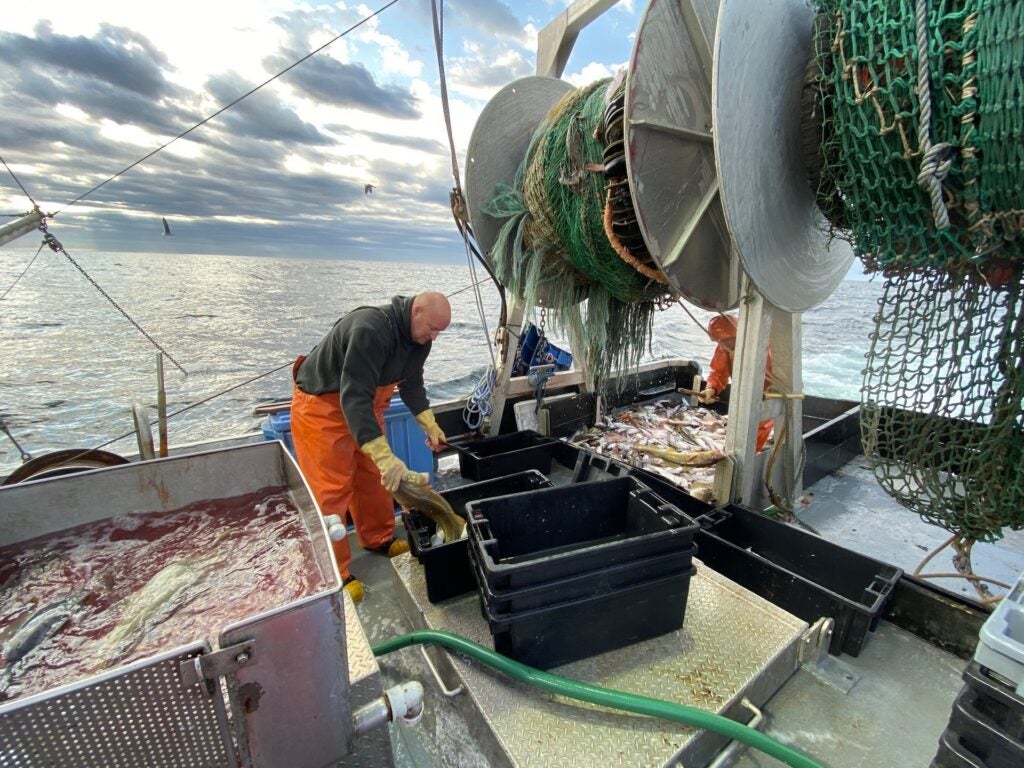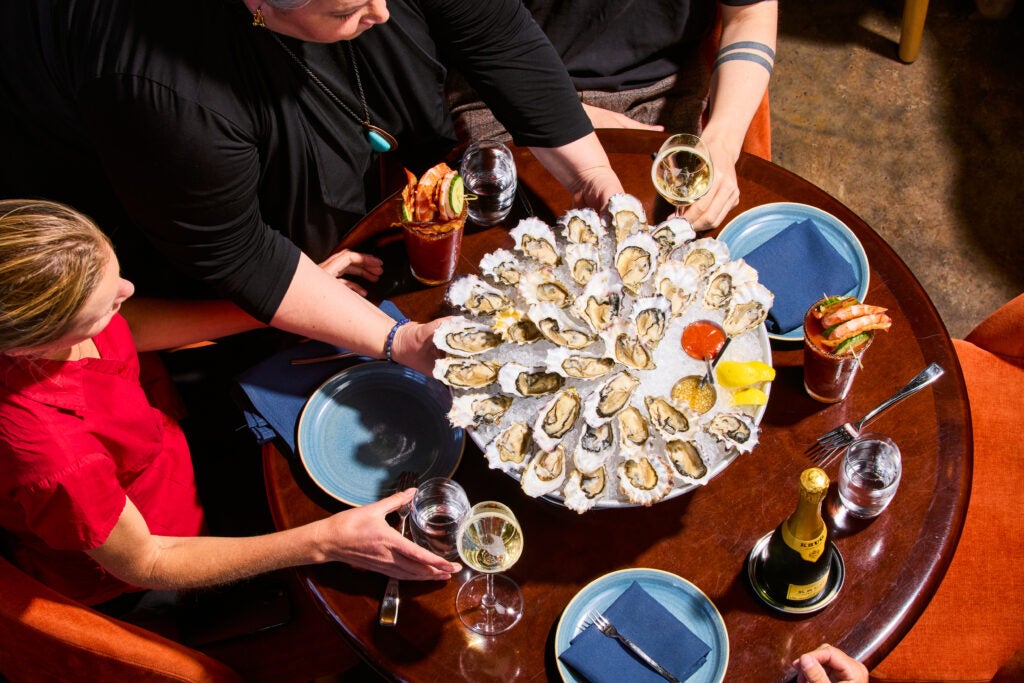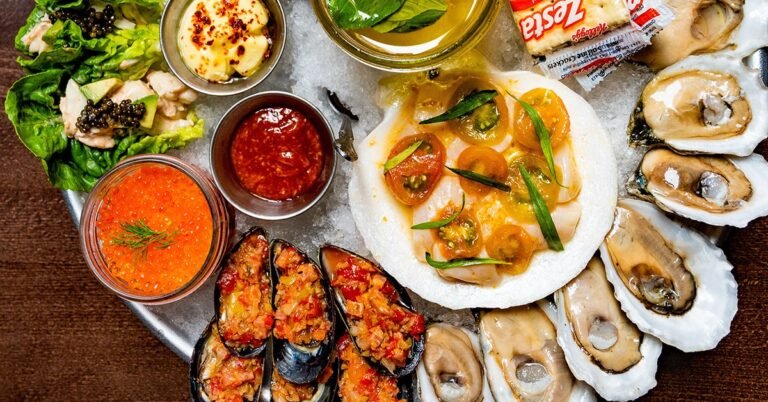As temperatures drop and sparrows and tourists fall into warm pastures, the Gulf of Maine begins to move with life. Divers roam the cold kelp forests looking for sea urchins for their precious university. In the cold season, sweet and firm oysters are harvested for immediate choking and sweep, finding their way to some of the country’s best restaurants. Scallops, Jonah Crabs and mussels are pulled from the depths and ready to be impressed by the bright briny flavor. As the calendar changes to each season, the state restaurants are truly alive and spoiled by the rich diversity of local seafood.
Maine’s postcard ready coastline has become synonymous with idyllic summer and Mayothrazor lobster rolls. 2024, Almost 8 million Tourists arrived between May and August. However, few people are thinking about winter tourism in Maine, and few look for seafood beyond the famous lobster and oyster staples. After Labor Day, many restaurants either limit time or embrace the reality of slower business.
But as summer fades, many fish shells have already moved north into Maine’s cool waters, fleeing the southern heat, and are fertile in flavour before heading south again in December. Not all Maine restaurants offer local seafood, but those who enjoy the benefits of uni, scallops, crab, tuna, oysters and mussels. In late autumn, visitors can take a walk to some of the state’s best restaurants without having to book, take a quick glimpse of the seafood forward menu, or feast on local catches with peak yummy.
Mr. Tuna of Portland.
I feel like I’ve been placed in a closely guarded secret and arrange an appointment with Mr. Tuna on a lively day in November. In his handroll shop, just off the main drag in Portland, Mr. Tuna swings me around to the minimal 14 seat counter. Shaking a sturdy knife, he slices it into a marble chunk of Atlantic blue-fin tuna, wraps it in Nori and places a handroll in front of me. Inside, you will find slightly firm sushi rice, a shower of green onions and floppy shiso leaves surrounded by underneath pickled radish. Tuna is sparkling pinkIt’s striped with fat as if you were touching a paintbrush, and this is one of my favorite seafood. “Straight from the waters of Maine,” he says with a laugh.
Mr. Tuna is Monica, co-owner, Chef Jordan Rubin. The counter of the same name, and Bar Fatwith his wife, Marisa Lewiecki. In Portland, Rubin has emerged as a local seafood advocate given his over 20 years of experience. That’s the philosophy he takes seriously in both restaurants. Mr. Tuna has local to everyone. Grilled creamy uni, Yu mayonnaise and crab, crackling tempura flakes and scallops, and melted tuna hand rolls were topped with everything from sweet mango slivers to Zasti drops. Kosho is moving.
However, the best tuna yield occurs between September and December, with shellfish like scallops and crabs being most delicately seasoned until March, but few visitors experience the best bounty . Besides Maine residents, Rubin says there are only a few chefs and insiders who can talk about the area’s incredible seafood. “In many cases, chefs need to try it out themselves,” he says. “When people in the industry visit Mr. Tuna, they’re like “holy shit.” How about this? ”
To understand how Maine supports its rich seafood, it’s just a matter of looking at the water. Who is Adam Baugs? Lead The Gulf of Maine Research Institute’s sustainable seafood program is rattling off geographical benefits right away. Offshore banks (the masses of the lands sold) create the ideal conditions for marine life. Many of the catches are also closer to the coastline. This means that the fisherman could take it to the chef on the same day. Additionally, the US is implementing strict allocations on the East Coast to prevent exploitative overfishing and habitat degradation. (Considering that Atlantic Bluefin tuna was once Considered Over-fishedtheir steady recovery may come as a surprise. ) “Over 90% of the bluefins along the North Atlantic coast are selectively harvested, one at a time, using rods and reels or harpoons,” says Rubin.

I’m on a trawler off the coast of Maine.
The most important thing for seafood quality is the water itself. It’s cold and vague, rich in plankton and small fish, and Maine Bay attracts hungry fish that fatten during summer and fall. Chilly temperatures prevent salt from entering the shellfish quickly. This allows for sweeter, more flavorful meat. As Baux proudly told me, “We are a kind of destination in the ocean and we tend to hold the species longer.”
It is also impossible to talk about main seafood without mentioning climate change or how it has impacted the environment. Gulf coastal oceans promote vitality in winter, but changing water temperatures have destroyed the environment. Once thriving cod and shrimp in the north have moved north past the main, making temperatures even colder. The change also welcomes new species. Traditionally discovered further south, Blacksea bass and squid are now available in Maine. This is the reality that main chefs, fishmongers and scientists work on all year round.
At Rubin’s two restaurants, he keeps further distance to ensure customers receive fresh seafood. Each week during the season, restaurants average around 400 pounds of catch. Some of it is offered on the spot. Otherwise, Rubin uses the restaurant’s super freezer. This allows you to extend the shelf life of your seafood for another 2-3 months. When bluefin tuna moves south and the frigid seas make fishing impossible, there is a Carolina Rubin source that schools of fish can find until Maine’s fishing season fishes at the end of summer.
Rare shellfish, uni and bluefin tuna are not the only ones that thrive in cold temperatures. Maine has a more common white fish variety that is present all year round, and according to Baux, it is also abundant in winter. 30 minutes south of Portland Biddeford, provider of Fish and Chips Fish and whistle We are working on working with main seafood throughout the season. On Jason Eckerson and Kate Hamm’s menu, everything is fresh, never frozen, and sourced from local fishermen happening to catch the week.

Jason Eckerson and Kate Hamte with fish and whistles.
Eckerson, who previously sourced seafood for Portland’s mainstay through his shop Eventide Oyster Co.hoping that customers will be interested in lesser-known Maine fish varieties such as Pollack, Hark, and Cask. “I wasn’t on the mission to serve something like this,” he says. “How do you talk about this without preaching? Because it’s fried fish.”
Outside of the state, chefs are looking for quality seafood in Maine, especially during the cold season. In Philadelphia, co-owner Alex Kempsheff My loop He regularly features local catches on the menu along with his partner Amanda Shulman. When winter arrives, he only sources mussels from Vans Island in Portland, Maine and Bangs Island at the University of Maine. Kemp insists that the main uni has no alternative. As a chef who cares deeply about seasonality, Kemp says that the main seafood never fails in quality and taste. But it’s really hard to hide bad seafood. ”
I wonder why some of the country’s top chefs guaranteed seafood in Maine have not appeared on the menu any more this season. First of all, not all restaurants are located in places where seafood comes from. This will help you raise your state profile. Plus, if the diners don’t know about Maine’s offerings, they won’t ask for them. This raises a bigger question. Seafood is a global product and it’s not always easy to source locally. Budget-friendly restaurants often choose farm-grown seafood for affordability and consistency, especially during the winter. Others may turn to foreign products like Japan that carry a particular cache. As Baukus points out, “it’s often easier to buy fish imported from other countries than to buy fish caught locally.”

San Francisco water bar.
Still, the main seafood continues to thrive during the cold season. Compared to Japan, Spain, Mexico and other global seafood markets, Maine operates on a much smaller scale. But the demand is still there and is growing slowly. Upstream Portland, a tuna wholesaler that only works with restaurants in Portland, Maine, reported that supply of bluefin tuna in the Atlantic has tripled over the past three years. These numbers represent the victory of chefs like Rubin and the Gulf of Maine Research Institute. “I want people to know how amazing our seafood is,” adds Rubin. “I would like to have the main seafood on the menu.”
In late December, I’m sitting in a dressed dining room Water BarA San Francisco restaurant overlooking the bay. Across me is Eric Heyman, the restaurant’s purchasing manager. That’s the fun and fanatic part of his work. At the water bar, Hyman makes all purchase decisions. That means they source everything from lobster to caviar and other exceptional seafood that catches eye.
For him, the state has always stood out for offerings offered responsibly different to his local waters. “Maine is cold enough for oysters to flourish in the summer and even better in the winter,” says Hyman. “And there are many small fishing communities we can support.”
Thousands of miles from Maine I scan the menu at the water bar and find state seafood featured in several dishes. Hyman guides me through his favourites: plump and meaty Damariscotta oysters, cornmeal-covered fish and chips from the Gulf of Maine, and crowd-pleasing lobster rolls. San Francisco – I imagine how far this seafood has come, as the Oakland Bay Bridge is completely visible and plates are scattered in front of me. I close my eyes, inhaling the aroma of oysters, and for a moment I am transported to the refreshing, fierce cold coast of Maine.


